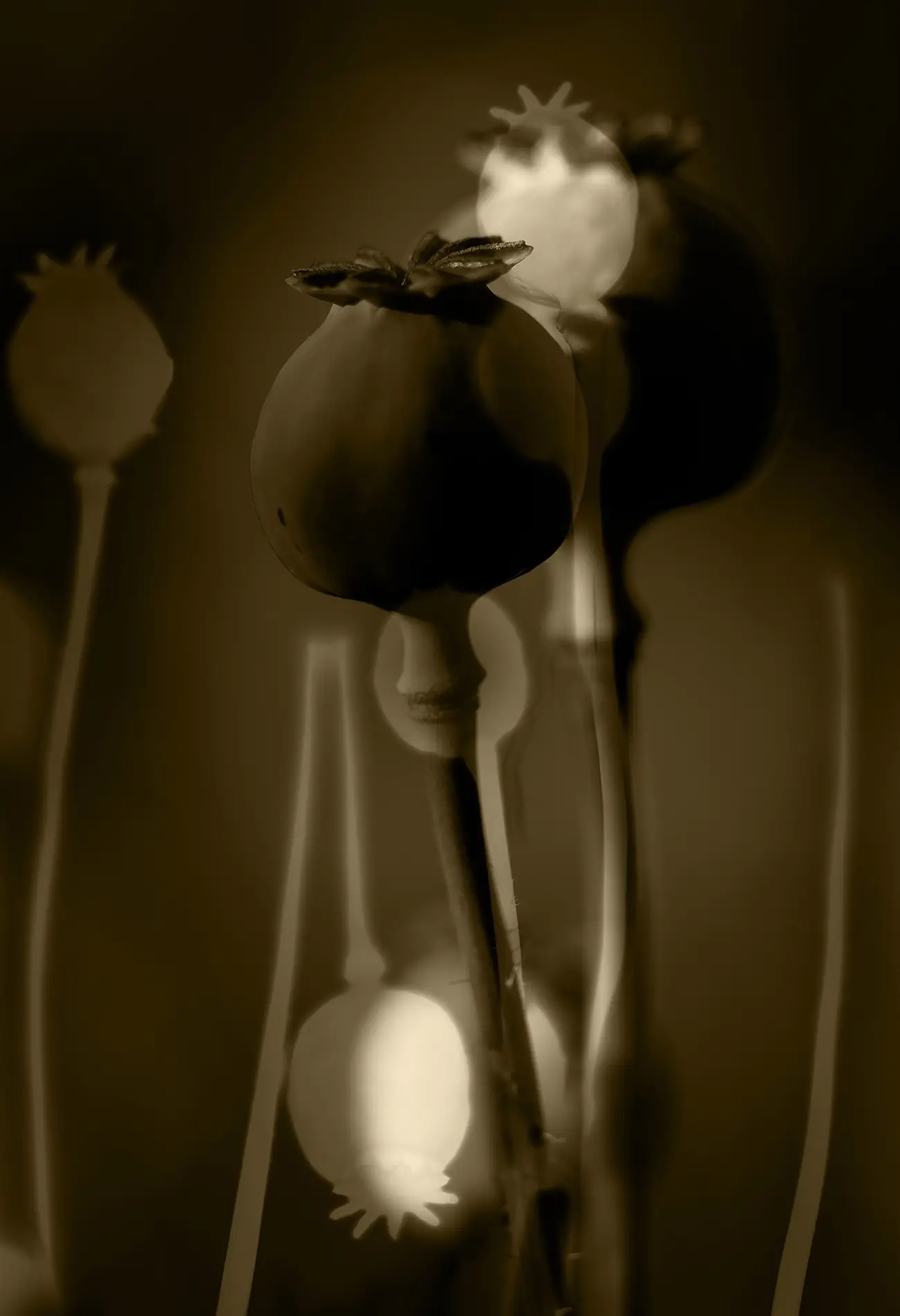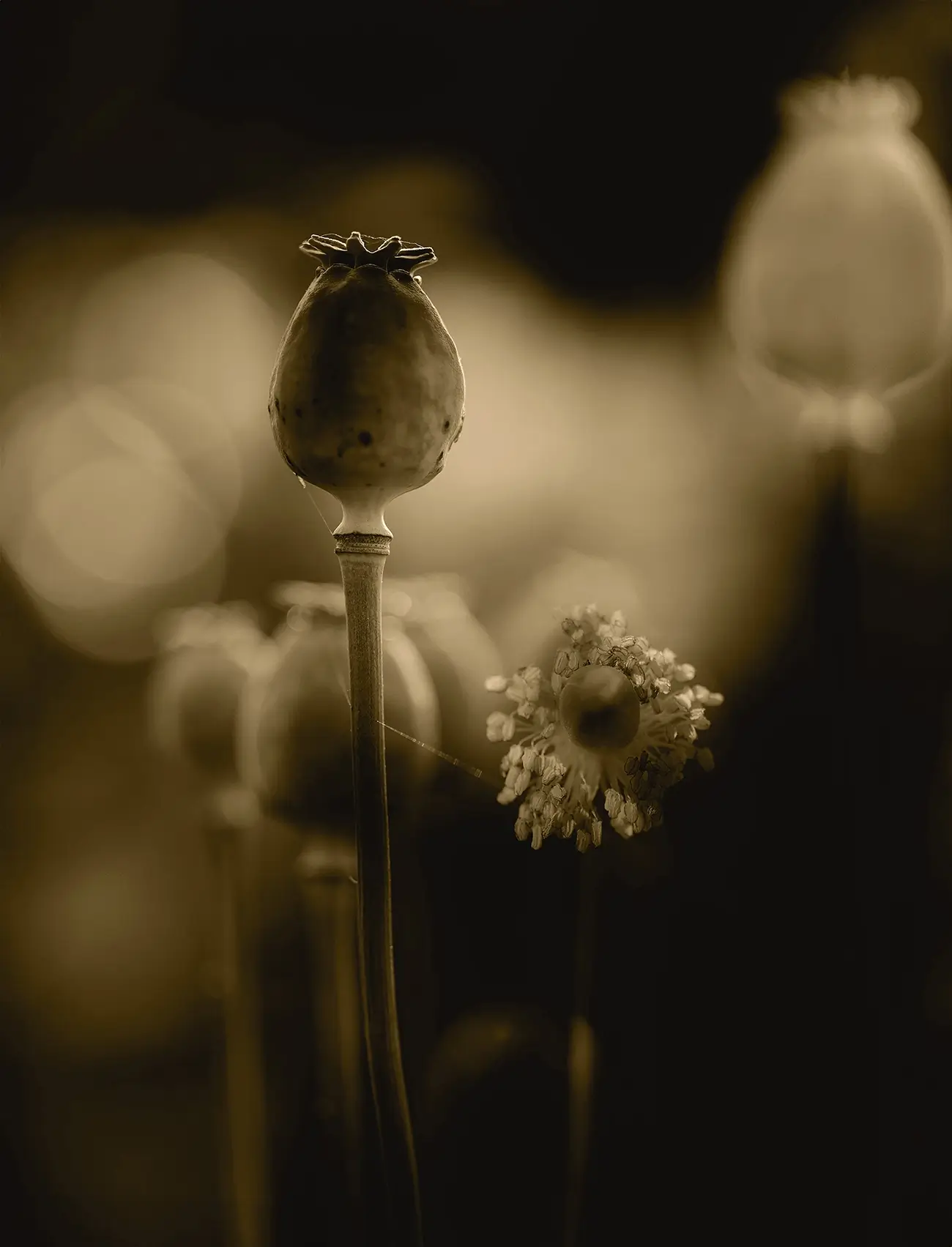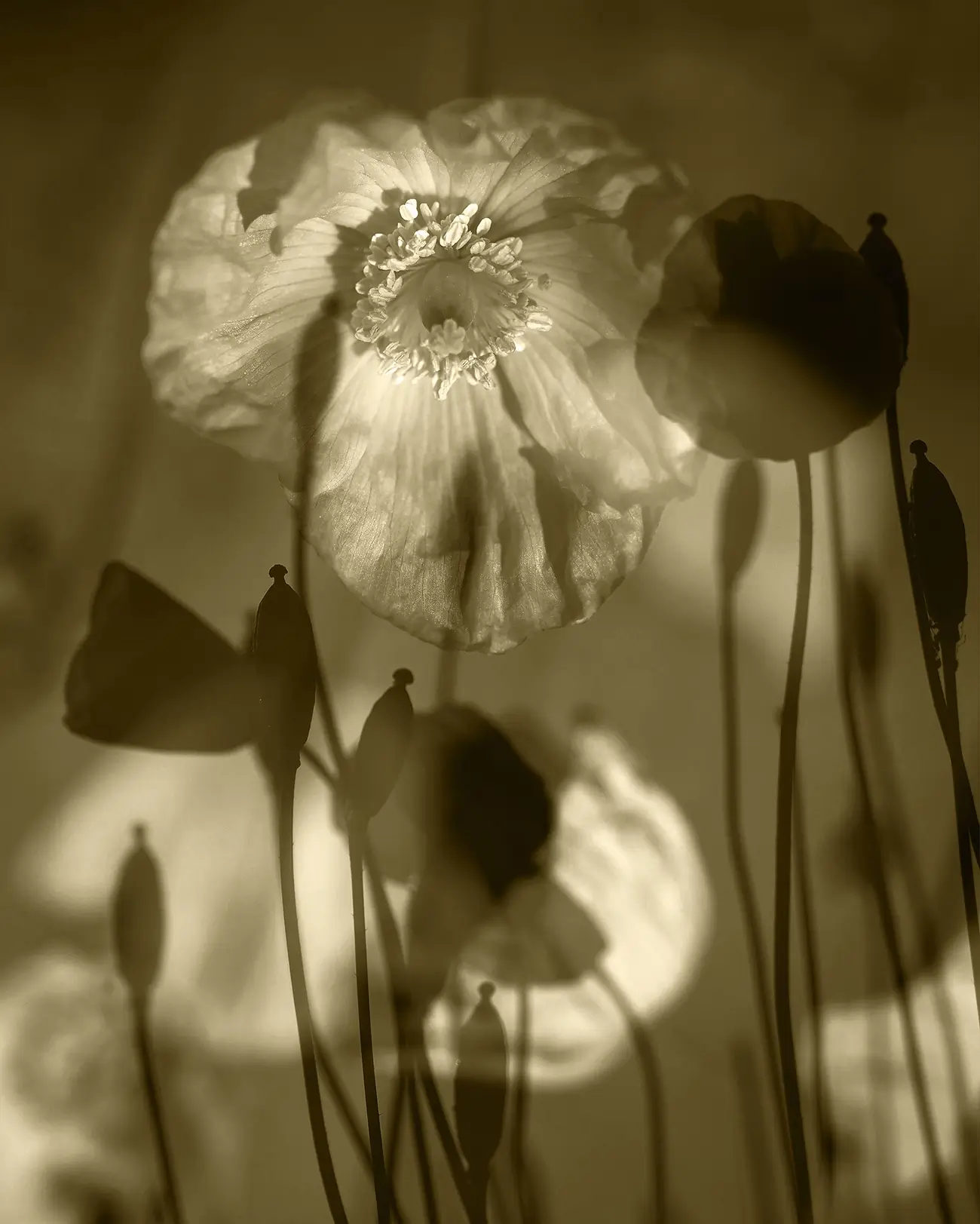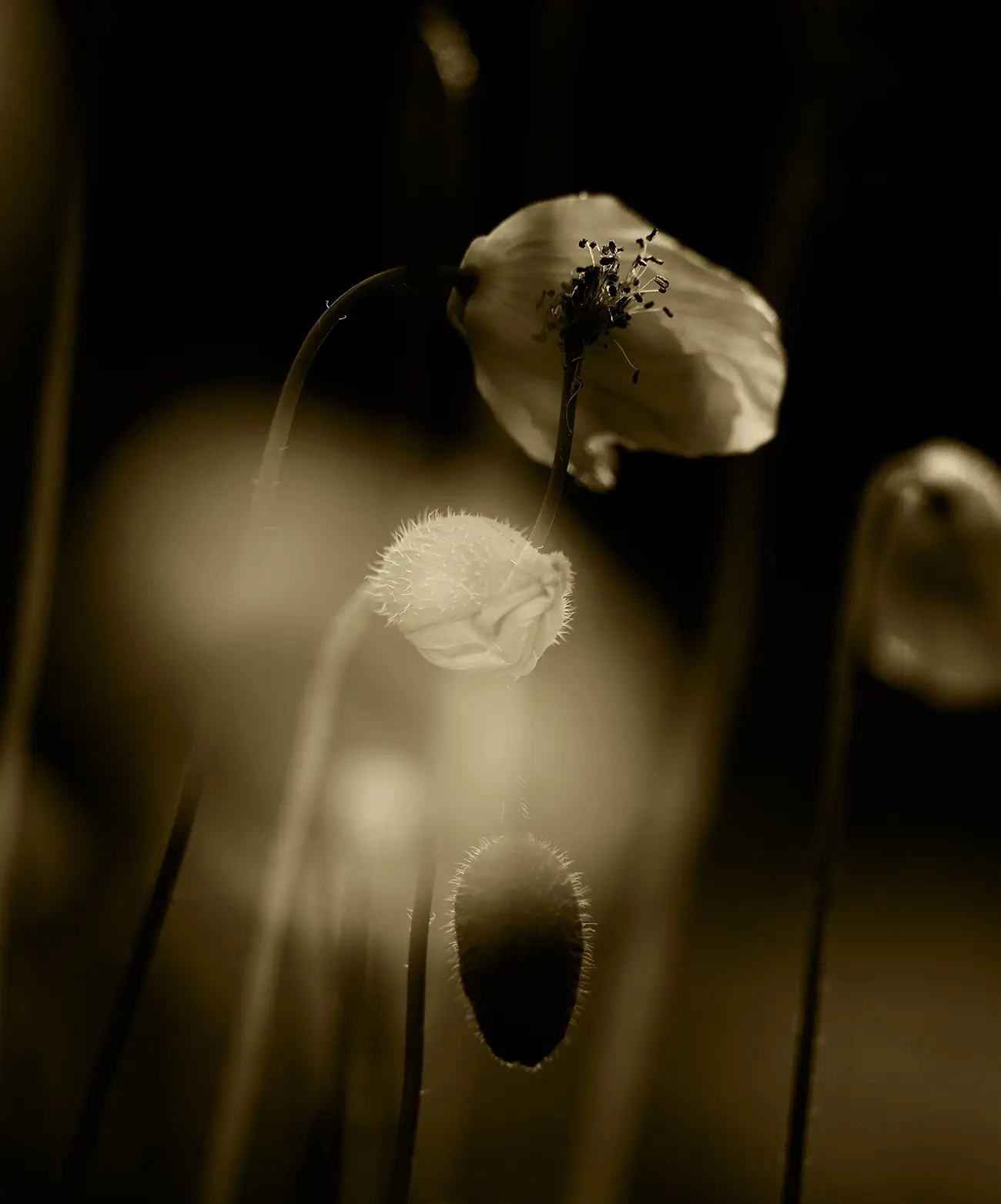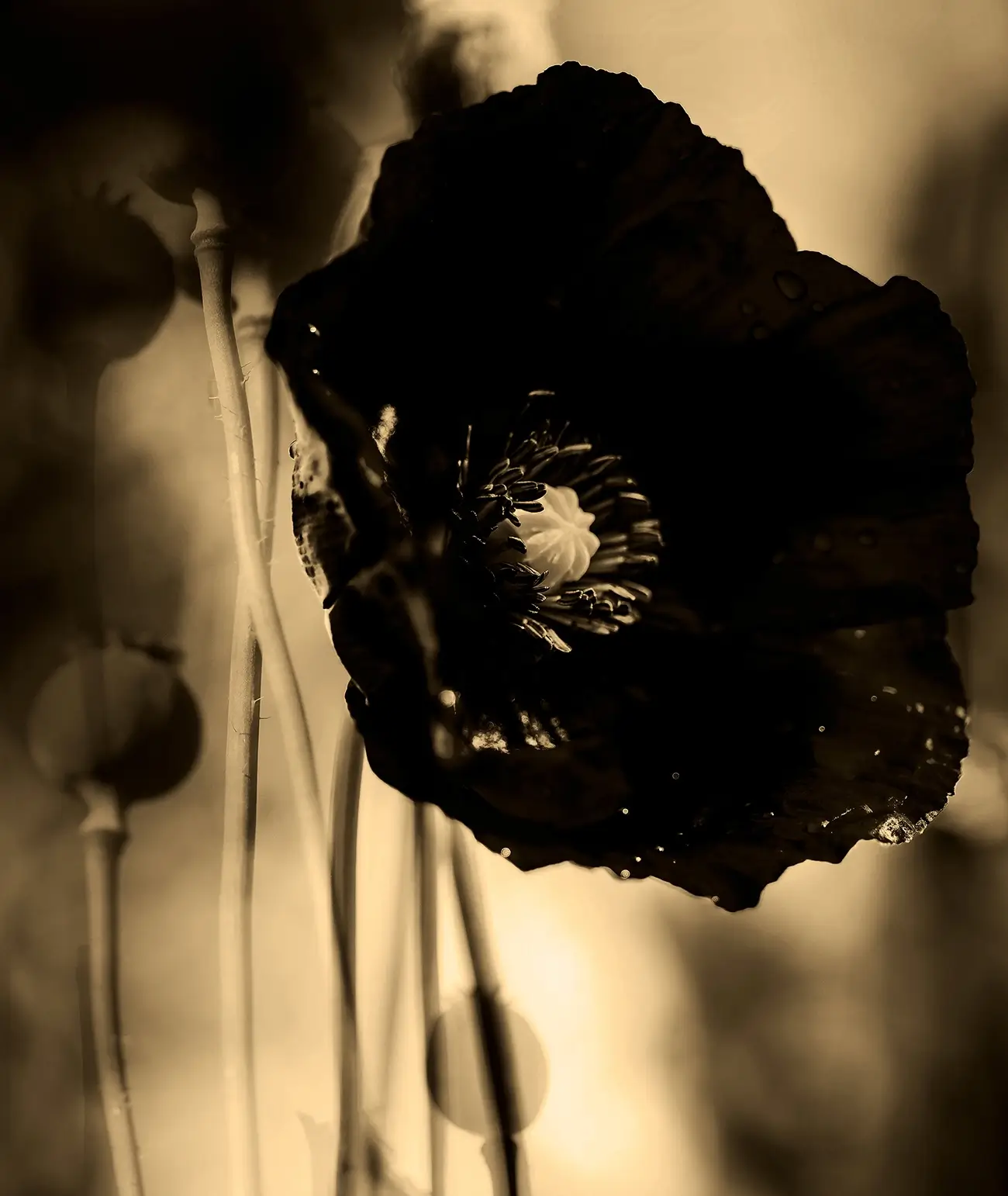Chinese-born photographer
Julie Wang brings a poetic, contemplative sensitivity to her visual exploration of the world. Having lived for nearly equal parts of her life in China, Europe, and the United States, she approaches her subjects with the nuanced perspective of someone shaped by many cultures. This blend of distance, curiosity, and emotional resonance infuses her work with a quiet depth, allowing her to reveal the fragile beauty and subtle tensions that often pass unnoticed.
Her series
The Illusion of Poppies, selected as the
Solo Exhibition for March 2025, reflects her lifelong fascination with art, literature, film, and the natural world. Although originally trained in medicine, Wang ultimately followed her instinct toward creativity — a path enriched by the constant relocations of her childhood and the cross-cultural experiences that defined her adult life. These influences converge in her photography, where external landscapes become mirrors for inner states, and fleeting moments take on the weight of memory or metaphor.
Inspired by poetry and painting from a range of traditions, Wang creates images that bridge personal emotion and universal experience. Through delicate atmospheres, thoughtful compositions, and a distinctly introspective gaze, she invites viewers into a world where reality blends with reverie — a place shaped as much by feeling as by observation.
We asked her a few questions about her life and work.
All About Photo: Could you share how you first came to photography — the early moments that shaped your path — and how your practice has evolved into the work you create today?
Julie Wang: I actually came to photography very simply — through my love of being outside and noticing small things in nature. I used to take photos just to show my family what I saw: a certain light on a flower, a small detail most people walk past. They were often surprised by how beautiful or unusual those moments were, and that’s when I started to realize I might have a “unique eye.”
In the beginning, my practice was nothing more than going outside as often as I could and making pictures. I learned by doing — how morning light feels different from evening light, how “bad” weather can create the best atmosphere, how patience changes your way of seeing. Being outside was really my first teacher.
Only later did I start looking at books and studying the work of master photographers. I loved analyzing why a particular image worked, what made it powerful or memorable. That habit helped me grow a lot. Over time, my photography became not just about observing nature but about exploring feeling, memory, and the quiet inner world that images can hold.
Your series The Illusion of Poppies began with a simple encounter—a poppy flower, a seed. What first drew you to the poppy, and how did those instinctive images in your mind lead you to realize the project was less about the flower itself and more about memory, perception, and the fluid nature of seeing? Do other subjects trigger this same intuitive response in your work?
I started photographing poppies when I found them in my local botanical garden and realized I could finally see them up close. They felt strangely familiar and unfamiliar at the same time. I didn’t even know their name at that moment, yet something in me seemed to recognize them. It reminded me of my years living in Germany, where I often saw fields of these flowers growing everywhere. They were so beautiful and abundant — and honestly a little shocking once I learned they were poppies. Growing up in China, I had never seen this flower in real life. It carried a kind of cultural weight, almost a warning. So encountering them again years later, in such a gentle, intimate way, stayed with me.
That mix of recognition and strangeness was what drew me in. Every time I saw a poppy — a flower, a pod, even just a stem — an image immediately surfaced in my mind. It felt instinctive, almost like memory speaking. And I realized pretty quickly that I wasn’t just documenting a flower. I was responding to something deeper: how early impressions shape the way we see, how perception changes when life moves across different cultures, and how beauty can be so fluid, shifting from stigma to tenderness.
I do have this intuitive response with other subjects too — seeds, withered flowers, small things in nature that hold a quiet emotional echo. But with poppies, the feeling was especially strong because they carried both personal history and a sense of rediscovery. That combination became the heart of
The Illusion of Poppies.
When editing the series, you said unconscious emotions guided you. How do you translate instinctive sensations into concrete visual decisions?
When I edit, I always start by looking at the photographs one by one and letting myself return to the moment I made each frame. I try to remember what drew me to that scene in the first place — the light, the shape, the feeling in my body. As I sit with the image, new sensations or even new images often appear in my mind. It sounds a little surreal, but it’s truly how it happens for me.
Those instinctive impressions become my guide. If a photo feels too heavy, I lighten it. If something feels too sharp, I soften it. If a shape wants to dissolve or drift into shadow, I let it. I’m not trying to control the picture — I’m trying to follow the feeling that first brought me to the subject.
In a way, editing for me is like listening. I’m translating something unconscious — a memory, an emotion, a small shift in perception — into tone, texture, contrast, and form. The decisions become concrete, but the source is always intuitive. That’s what makes the process feel almost magical.
Discovering the Buddhist concept of Dukkha during this project seems pivotal. How did this idea of impermanence and illusion emerge through photographing poppies?How does the notion that “nothing is solid, everything is shifting” influence the way you approach both photography and daily life?
Discovering the idea of
Dukkha — the Buddhist understanding that everything is temporary, unstable, and unable to offer lasting satisfaction — was really the starting point for this series. Once I learned that, I couldn’t look at poppies the same way. Their whole existence is a perfect expression of that teaching: they bloom briefly, collapse into themselves, and dissolve into seeds and shadow almost before you can catch them. Photographing them made the concept feel real, not theoretical. It showed me how fragile every moment is, and how quickly things shift.
That awareness changed the way I approached the work. Instead of trying to “capture” something permanent, I began to follow what was disappearing — the fading light, the dissolving contour, the moment right before something changes its shape. I allowed the images to blur, break apart, or drift away if that’s what the feeling called for.
And honestly, this idea has moved into my daily life too. I’m more aware that everything — feelings, seasons, relationships, even the smallest moments — is always in motion. Nothing is fixed. That can be sad, but it’s also very freeing. It helps me pay attention, accept change, and keep making work from a place of openness rather than control.
The series allows forms to fade, edges to blur, and details to dissolve. How intentional was this in communicating the instability of perception?
The fading forms and blurred edges were intentional, but not in a heavy, conceptual way. They came naturally from how I experienced the poppies — always shifting, never fully solid. When an image felt too clear or too defined, it no longer matched the feeling I had in that moment. Letting things dissolve was my way of showing how perception itself is unstable, how what we see is always changing even as we try to hold it still.
Your series uses a distinct sepia palette, fluid sequencing, and a balance between abstraction and realism. What drew you to this tonal choice, how did the open, non-linear structure guide your editing, and do you see the images as representations of poppies or as reflections of inner states and impressions?
I chose the sepia tone because it sits somewhere between color and black-and-white. It still carries a trace of the real world, but it also softens everything into something more internal and abstract. For me, sepia feels like memory — warm, a little unstable, not entirely fixed. It lets the images drift between presence and imagination.
Because of that, the series never needed a strict sequence. Any image could be the beginning. I wanted the whole project to feel fluid, like perception itself — always shifting. When I edited, I followed the emotional rhythm rather than a linear narrative, placing images together by tone, breath, or a feeling they shared.
And in the end, I don’t see these photographs as depictions of poppies in the literal sense. They’re more like reflections of inner states — what the poppies stirred in me, what surfaced in my mind, what felt true in that moment. The flowers are there, but they’re also a way to explore perception, memory, and the blurred space between what we see and what we feel.
What do you hope viewers reconsider about seeing, memory, or perception when encountering this work?
What I hope viewers reconsider is the idea that seeing is ever straightforward. We often think we look at something and understand it, but in reality our seeing is shaped by memory, culture, emotion, and whatever moment we’re standing in. With this work, I want people to slow down and notice how their perception shifts — how a flower can feel tender, haunting, or familiar depending on what they bring to it.
If the series encourages viewers to question what is “real” in an image, or to recognize how much of their own inner world enters the act of seeing, then I feel the work is doing its job. I’m not asking them to find answers, just to stay open to the fluid, changing nature of perception itself.
How do you feel about photography’s paradox—preserving a fleeting moment while knowing the moment has already slipped away?
I’ve always felt that this paradox is exactly what makes photography so moving. A photograph preserves a moment, yes — but only after the moment has already disappeared. That tension is the reason I’m drawn to the medium. It’s a quiet reminder that nothing can be held, not even the things we try hardest to keep.
When I make an image, I’m very aware that the real moment is gone forever, and what I’m left with is only a trace — a residue of light, memory, and feeling. But I don’t find that sad. I think it’s honest. The photograph isn’t the moment itself; it’s a way of acknowledging its passing.
For me, photography is less about stopping time and more about noticing it — how it moves, how it slips through us, how it reshapes what we see. Every picture becomes a small conversation between what was there and what remains in us afterward. That paradox is what keeps me curious, and what keeps me making work.
How would you describe your photographic style, especially in relation to The Illusion of Poppies?
I would describe my photographic style as quiet, intuitive, and emotionally driven. I’m always drawn to the small, delicate things in nature — flowers, seeds, shadows, subtle movements — and I try to photograph them in a way that feels more like a memory or an inner sensation than a literal description.
With The Illusion of Poppies, this became even more pronounced. The work leans toward abstraction, soft transitions, and dissolving forms. I wasn’t trying to show what a poppy “looks like,” but what it feels like — how it appears in that brief moment when perception mixes with memory, emotion, and the instability of light.
My style sits somewhere between realism and dream. The subjects are real, but the tones, textures, and atmosphere create a more inward space. I think of the images as visual poems rather than documents — a way of expressing what’s shifting, fragile, or hard to put into words.
What inspires your unique storytelling and approach to visual metaphors?
My storytelling really comes from paying attention to small things in nature and noticing how they echo something inside me. I’m often inspired by quiet moments — a seed falling, a fading flower, a shadow moving across a wall. These simple things feel like metaphors on their own, and I respond to them instinctively. I never plan a story in advance; it’s more like the image gives me a feeling, and I follow that feeling.
I think my approach to visual metaphors comes from how I see the world. I’m drawn to what is fragile, in-between, or changing — things that hold a kind of emotional truth even when they’re very small. When I photograph them, I’m not trying to describe the object itself. I’m trying to express the sensation or memory it brings up in me. The metaphor appears naturally through tone, light, or the way the form dissolves.
So my “storytelling” isn’t about creating a narrative. It’s more about creating a space — a quiet, open space where the viewer can bring their own feelings and thoughts. In that way, the images become metaphors not just for me, but for anyone who looks at them.
Whose work has influenced you most as a photographer? How do you continue educating yourself to evolve as an artist?
I’ve learned almost everything by looking deeply at the photographers I love. Rinko Kawauchi, Masao Yamamoto, Minor White, Josef Sudek, and Harry Callahan have all shaped me in different ways. From them, I learned that photography can be quiet and poetic, that small things can feel vast, and that an image can express an inner state rather than just describe the world. Their work still reminds me of what is possible.
Because I’m self-taught, my education has always come from curiosity. I spend a lot of time studying books, analyzing why certain images move me, and paying attention to how these photographers handle light, form, and emotion. I also learn constantly by being outside, photographing, and noticing how everything changes with time, weather,
and mood. Editing has become another teacher — it shows me what I truly feel and helps clarify my voice.
I think I keep growing by staying open: by looking, reading, observing, and letting the images guide me. That process of learning never really ends, and I like it that way.
What does photography mean to you personally—emotionally, creatively, or spiritually?
Photography, for me, is a way of staying close to life. Emotionally, it helps me pay attention to moments I might otherwise pass by — small things in nature, quiet details that carry a feeling. When I photograph them, I feel more connected, more grounded. It’s almost like the camera gives me permission to slow down and breathe.
Creatively, photography is where my intuition lives. I don’t follow strict plans or concepts. I respond to what I feel — a shift of light, a fragile shape, something dissolving or becoming. The camera becomes a bridge between what I see outside and what I sense inside. Editing then becomes a second moment of discovery, where feelings I didn’t even know I had began to surface.
Spiritually, I think photography teaches me acceptance. It constantly reminds me that everything is temporary — a flower, a shadow, a season, even a mood. The moment I press the shutter is already gone, and somehow that makes the image even more meaningful. Photography helps me understand impermanence in a gentle way. It doesn’t try to hold time still; it simply honors the passing of it.
In the end, photography feels like a quiet conversation between myself and the world — one that keeps changing and keeps teaching me something.
What do you believe makes a strong photograph stand out from an average one?
For me, a strong photograph is one that carries a feeling the moment you see it. It doesn’t need to be perfect or complicated — it just needs to have something alive inside it. A strong image has a kind of presence, a quiet tension or emotion that makes you pause. It invites you to look again, to stay with it a little longer.
An average photograph might show something clearly, but a strong one makes you feel something, even if you can’t explain why. It has intention, sensitivity, and a sense of honesty. You can sense that the photographer truly saw something — not just with their
eyes, but with their whole self. That sense of inner clarity is what makes an image stand out to me.
What are your artistic goals moving forward?
Moving forward, my goal is simply to keep growing into the artist I want to be. I don’t mean that in a big or grand way — I mean staying true to my own voice, continuing to refine my way of seeing, and making work that feels honest to me. I want to keep developing projects that come from curiosity and emotion, not pressure or expectation.
I hope to keep learning, keep experimenting, and keep challenging myself to see more clearly. If I can stay connected to my intuition and continue creating images that feel meaningful, then I feel I’m moving toward being the kind of artist I hope to become.
Is there anything else you’d like to share?
Maybe the only thing I’d add is that in a world filled with so many opinions, ideas, and concepts, I’ve learned it’s important to keep a little distance and stay true to yourself. It’s easy to feel overwhelmed, especially in the art world, but I think the most meaningful work comes from listening quietly to your own voice and trusting what moves you. For me, that simple honesty has become the most important part of my practice — and I hope it encourages others to do the same.




